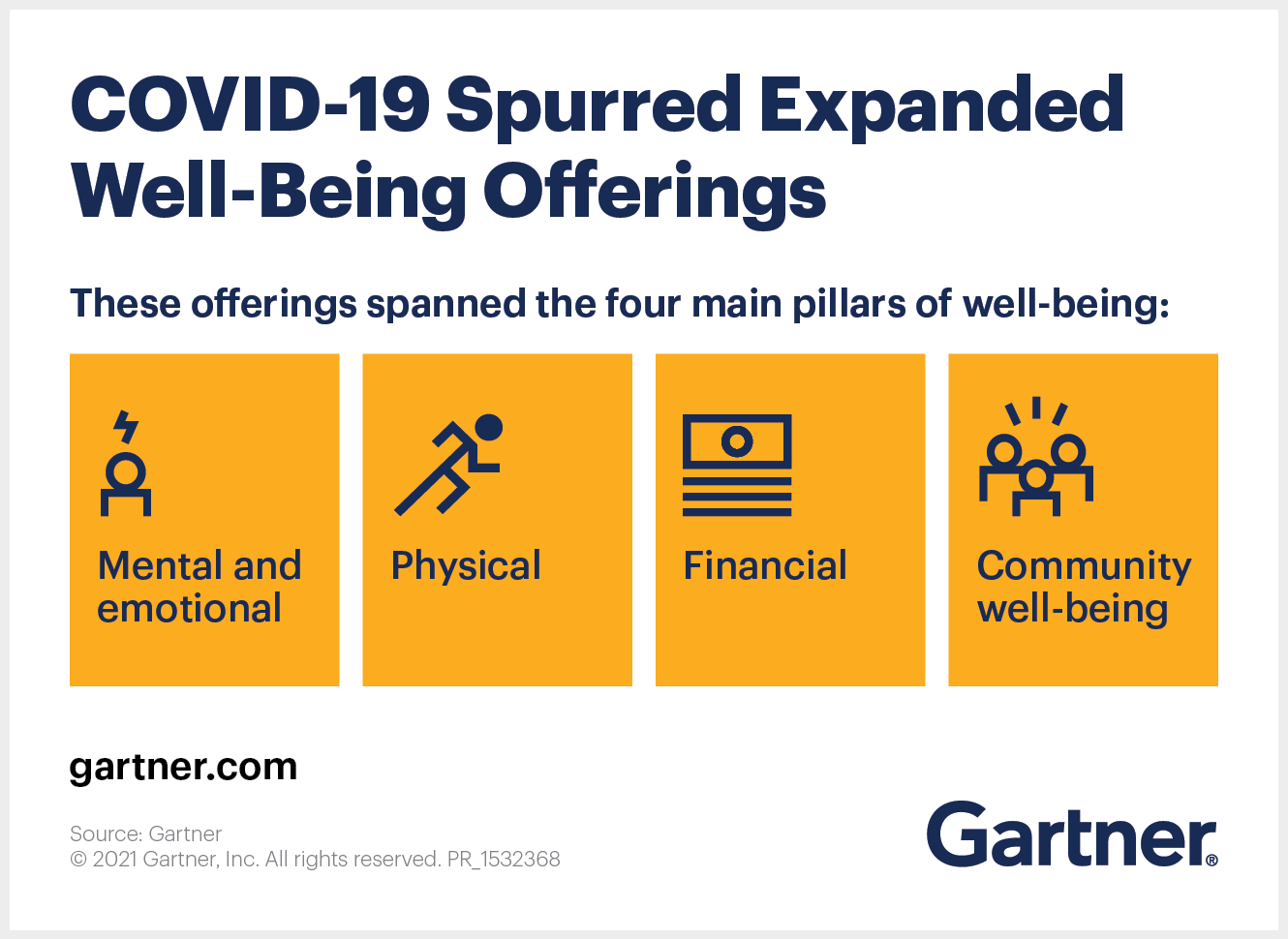October 27, 2021
- Gartner client? Log in for personalized search results.
5 Key Trends That Make Well-Being Programs Effective
Contributor: Teresa Zuech
If, like most organizations, yours is expanding its offerings, stay on top of these trends to ensure you deliver value.
Gartner research shows that most organizations added or expanded well-being initiatives in response to the COVID-19 pandemic in 2020. Mental and emotional well-being programs were the most common additions, but offerings also grew in other key areas: physical, financial and community well-being.
Despite budget constraints, only 6% of HR leaders said their well-being budgets decreased in 2020, while 46% reported obtaining more budget.
“It’s clear HR leaders see these programs as critical to talent outcomes, such as engagement and employee wellness,” says Brent Cassell, VP Advisory, Gartner. “Still, well-being programs are only valuable if they are effective and employees actually use them.”
To ensure you focus on those services most likely to have an impact, consider these five emerging trends.
Download now: Reinvent Your EVP for a Postpandemic Workforce
No. 1. Increased tracking of effectiveness and return on investment (ROI)
Gartner research shows that just 10% of HR leaders tracked well-being ROI with formal, quantitative metrics in 2020.
Where metrics are used to measure effectiveness, the most common focus was on program participation rates, employee engagement and medical claims data.
However, to really see the value of these offerings, you should also track employee mental health, employee-reported behavior changes and employee productivity.
No. 2. More mental well-being options
Organizations offered a variety of mental well-being tools in 2020, with employee assistance programs (EAPs) being practically universal, but the adoption of counseling services, education, and mental health assessments increased significantly.
Notably, the use of smartphone apps and support groups doubled. This is consistent with self-care tools becoming an important new type of offering — which also proved to have the highest impact on employee engagement among services Gartner measured.
No. 3. Virtual options for physical well-being
Some of the most common physical well-being offerings in 2020 included on-site immunizations, exercise competitions, nutrition or healthy diet promotion, and ergonomic support. Naturally, many of these programs were disrupted at the onset of the pandemic.
As a result, many organizations looked for tools to support their remote employees’ physical well-being, including offerings that could be virtualized. For instance, employees with gym memberships received app subscriptions for virtual classes.
As a hybrid work environment becomes the new norm, employers will need to continue to innovate in providing physical well-being support, whether that’s virtually, in homes or while in coworking spaces.
No. 4. Emphasis on financial planning and community engagement
The pandemic proved financially disruptive even for those not laid off or furloughed. Accordingly, Gartner research shows that the most common financial well-being offerings in 2020 focused on self-service financial planning tools and financial education classes.
At the same time, though, many employees increasingly want to improve community well-being through volunteering and charitable giving. Employers are, therefore, offering more opportunities such as work-sponsored volunteer projects, charitable donation matching and paid time off for volunteer work.
“Looking at how these offerings affect employee engagement, it’s clear employees care whether the organization makes a tangible, financial commitment to supporting their volunteer and charitable giving,” says Cassell. “In today’s environment, it’s critical that organizations not just voice support for the causes their organizations value, but also take action.”
No. 5. Opportunity to boost participation
For well-being programs to be effective, employees must use them, but a shocking gap exists in awareness about these services. Gartner research shows that 96% of organizations say they offer mental/emotional well-being benefits, but only 42% of employees believe their employer provides them.
To bridge this gap, make sure that managers know what exists and actively and openly discuss well-being services with employees when appropriate. This contributes to increasing awareness and reduce stigma around mental health. It also helps to personalize the options for employees trying to achieve their individual well-being goals.
Gartner ReimagineHR Conference
Join your peer CHROs and senior HR executives from leading organizations to discuss specific HR challenges and learn top HR trends and priorities.
Recommended resources for Gartner clients*:
How Well-Being Programs Are Evolving for a Post-Pandemic World
*Note that some documents may not be available to all Gartner clients.
